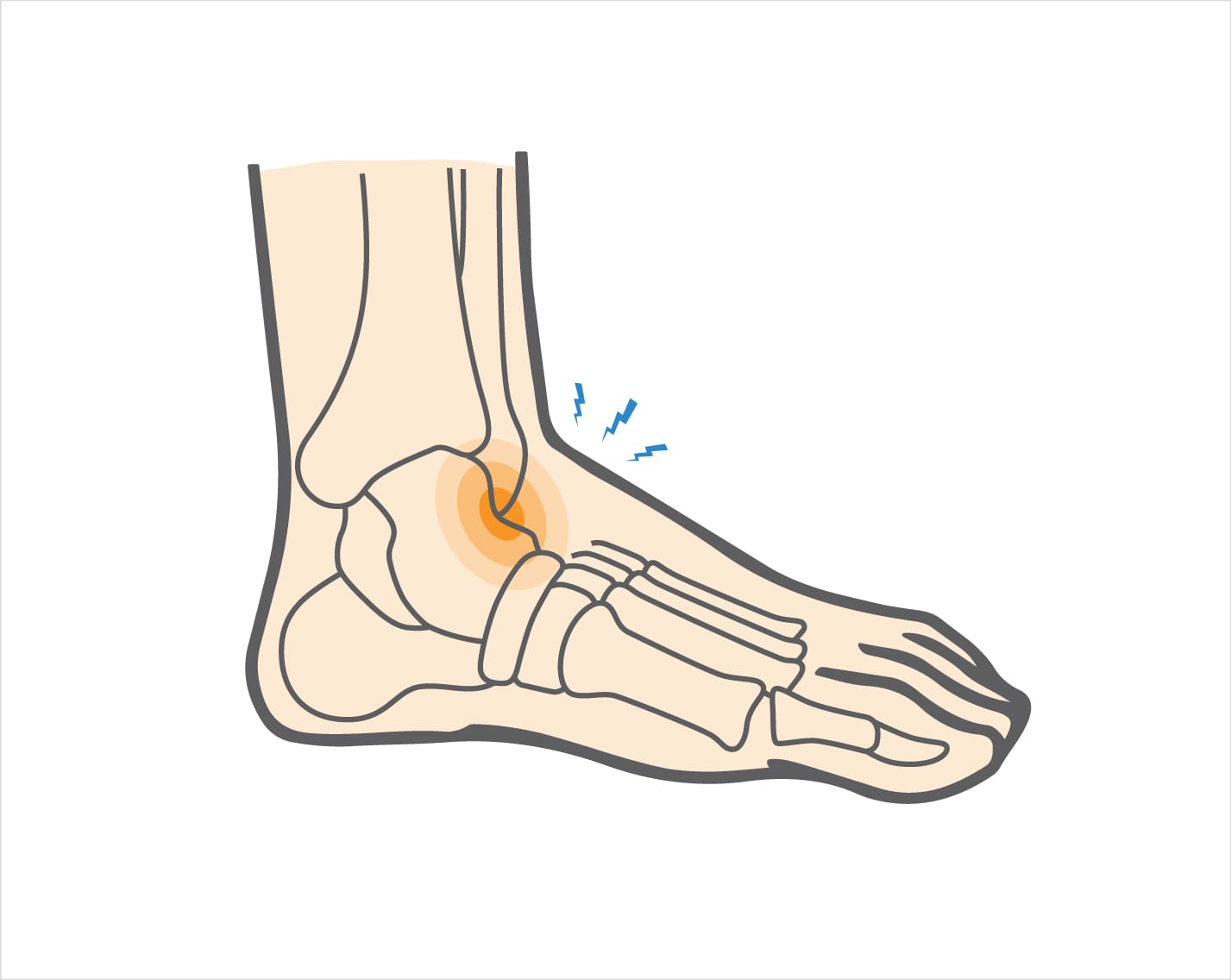Anterior ankle impingement (anterior), sometimes called “footballer’s ankle,” is a common source of chronic ankle pain among athletes. It causes pain in the front of the ankle joint and is caused by a buildup of scar tissue or bone spurs, usually in response to an acute injury or chronic stress on the ankle.
Ankle Impingement (Anterior) Causes, Symptoms & Treatment
Anterior ankle impingement (anterior) is a common source of chronic ankle pain among athletes. This condition, sometimes called "footballer's ankle," causes pain in the front of the ankle joint. It's caused by a buildup of scar tissue or bone spurs, usually in response to an acute injury or chronic stress on the ankle.
Overview
Overview

What causes Ankle Impingement (Anterior)?
There are several causes of anterior ankle impingement. A common cause is a chronic, repetitive strain on the ankle due to playing sports or excessive training. Activities that require repetitive bending of the foot upward (dorsiflexion) can lead to this condition. This repetitive movement can lead to dorsiflexion pain. Another cause of anterior ankle impingement is trauma to the ankle, such as a recurrent ankle sprain that results in ankle instability.
Anterior ankle impingement is most common in these sports:
• Football
• Soccer
• Volleyball
• Running
• Ballet
• Basketball
Symptoms
Athletes with anterior ankle impingement usually experience front ankle pain when they bend it upwards. This pain may be particularly evident when squatting, kneeling, or walking up inclines or stairs. Common symptoms also include:
- Dull ache when resting
- Tenderness to touch
- Front ankle pain and swelling
- Locking of the ankle joint
- A sensation of ankle pinching may also occur when the foot is bent upward.
When to see a doctor
You should see your doctor for an expert diagnosis if you have symptoms associated with an anterior ankle impingement. Your doctor will ask questions about your injury, the symptoms you’re experiencing, and the sports you play. A physical examination will be conducted to identify areas of tenderness and swelling. You may be asked to bend your ankle forward to test your range of motion. You may also be asked to perform a simple ankle impingement test involving lunging forward and keeping your heel on the floor. Imaging tests, such as an X-ray or magnetic resonance imaging (MRI) test, help identify bone spurs or other conditions causing your symptoms, including soft tissue impingement.
Non-operative treatment
Treatment of anterior ankle impingement usually involves rest and avoiding activities that will aggravate your injury, such as squatting, lunging, running up hills, cutting, or jumping. Conservative treatments also include:
• Ice
• Elevation of the leg
• Compression
• Nonsteroidal anti-inflammatory drugs (NSAIDs), such as ibuprofen and naproxen, to relieve pain
• Corticosteroid injections for cases of severe inflammation
• Wearing a special ankle brace to support your ankle and protect it from re-injury
• Physical therapy exercises
Try these exercises to help address your condition:
Below is a PDF of the Exercise Program
Surgical Treatment
Surgery may be recommended for severe cases of anterior ankle impingement or cases that do not improve with conservative treatments. Surgery allows the removal of bone spurs or scar tissue. There are risks to having surgery. These include removing too much bone and causing instability. Another risk is restoring motion to an arthritic joint, which may cause increased pain. Your doctor and orthopedic surgeon can advise if surgery is the best treatment option for you.
Recovery
Recovery time after an anterior ankle impingement can vary widely depending on the extent of the injury. Typically, it takes four to six weeks for athletes to return to their normal activities. Recovery time can take longer for severe cases. Physical therapy will be important in an athlete’s recovery and return to play. Treating dorsiflexion pain and eliminating ankle pinching sensations are key recovery goals.
GET BACK TO WHAT YOU LOVE. FASTER
Sources
https://physioworks.com.au/injuries-conditions-1/anterior-ankle-impingement
https://www.vivehealth.com/blogs/resources/anterior-ankle-impingement
https://www.sportsmd.com/sports-injuries/foot-ankle-injuries/anterior-ankle-impingement/#What_is_Anterior_Ankle_Impingement
https://emedicine.medscape.com/article/85311-clinical#b5
Frequently Asked Questions
Who commonly experiences this condition?
It’s often seen in active individuals, especially those involved in football, soccer, dance, basketball, and running, who frequently bend their feet upward (dorsiflexion).
What are the usual signs I might notice?
People typically notice a feeling of tightness or sensitivity in the front of the ankle, especially during movement. Some may feel a light pinch or restriction when bending the foot upward..
How is it diagnosed?
A combination of a physical exam, motion testing, and imaging (like X-rays or MRI) helps provide a clear picture of what’s happening in the ankle.
What activities might make the ankle feel stiff or tight?
Movements that involve frequent upward flexing of the foot, like climbing stairs, kneeling, lunging, or landing from jumps, can cause pain and a feeling of tightness in the area.

